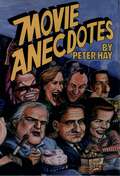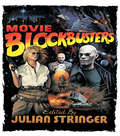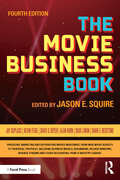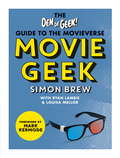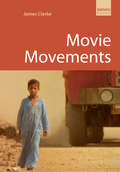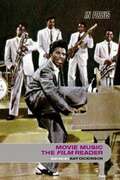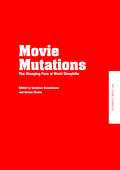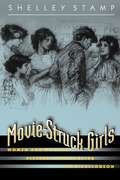- Table View
- List View
Movie Anecdotes
by Peter HayHollywood, Walter Winchell quipped, is where they shoot too many movies and not enough actors. Always looking for an angle, always, scheming, always the scene of clashing egos, the movie industry is where they place you under contract instead of observation--and if you don't have anything nice to say, write it down. "In 1940, I had my choice between Hitler and Hollywood," French director René Clair recalled, "and I preferred Hollywood--just a little." In Movie Anecdotes, Peter Hay treats us to a delightful ride through the world that has captivated audiences for almost a century, with stories that are often hilarious, sometimes tragic, and always entertaining. He takes us from the rough-and tumble early days (when one studio paid Pancho Villa $25,000 to launch his attacks only in daylight, after a film crew had set up) to the studio era (when Joan Crawford refused to cross the street on the MGM lot except in a chauffeured limousine) to the shenanigans of today's global industry. Here are stories about all the legends: Charlie Chaplin, Greta Garbo, John Barrymore, Mae West, Lucille Ball, Marilyn Monroe, Errol Flynn, Humphrey Bogart, Bette Davis, Judy Garland, Sophia Loren, John Wayne, and, of course, Ronald Reagan. There are the great directors from D.W. Griffith, Hitchcock, and Eisenstein, to Kurosawa, Bergman, Visconti, Huston, Ford, and Woody Allen. And Hay has selected tales of the writers, the wits, and the grand moguls, including perhaps the largest collection of Goldwynisms--both genuine and apocryphal. Along with the laughter, this volume recreates the conflicts that have torn the movie world, from battles over money and contracts, to discrimination, divorces, and scandals. Colorful, incredible, bitter, funny--the stories about moviemaking are as fantastic as the pictures themselves. Now they have been gathered together in an irresistible bouquet that is certain to delight every movie buff and provide fascinating insights for serious students of film.
Movie Bliss: A Hopeless Romantic Seeks Movies To Love (Mills And Boon E Ser. #3)
by Heidi RiceThe Romance Lover's Guide to Movie Must-Sees
Movie Blockbusters
by Julian StringerBig-budget, spectacular films designed to appeal to a mass audience: is this what - or all - blockbusters are? Movie Blockbusters brings together writings from key film scholars, including Douglas Gomery, Peter Kramer, Jon Lewis and Steve Neale, to address the work of notable blockbuster auteurs such as Steven Spielberg and James Cameron, discuss key movies such as Star Wars and Titanic, and consider the context in which blockbusters are produced and consumed, including what the rise of the blockbuster says about the Hollywood film industry, how blockbusters are marketed and exhibited, and who goes to see them. The book also considers the movie scene outside Hollywood, discussing blockbusters made in Bollywood, China, South Korea, New Zealand and Argentina
Movie Blockbusters
by Julian StringerBig-budget, spectacular films designed to appeal to a mass audience: is this what - or all - blockbusters are? Movie Blockbusters brings together writings from key film scholars, including Douglas Gomery, Peter Kramer, Jon Lewis and Steve Neale, to address the work of notable blockbuster auteurs such as Steven Spielberg and James Cameron, discuss key movies such as Star Wars and Titanic, and consider the context in which blockbusters are produced and consumed, including what the rise of the blockbuster says about the Hollywood film industry, how blockbusters are marketed and exhibited, and who goes to see them. The book also considers the movie scene outside Hollywood, discussing blockbusters made in Bollywood, China, South Korea, New Zealand and Argentina
The Movie Business Book
by Jason E. SquireTapping experts in an industry experiencing major disruptions, The Movie Business Book is the authoritative, comprehensive sourcebook, covering online micro-budget movies to theatrical tentpoles. This book pulls back the veil of secrecy on producing, marketing, and distributing films, including business models, dealmaking, release windows, revenue streams, studio accounting, DIY online self-distribution and more. First-hand insider accounts serve as primary references involving negotiations, management decisions, workflow, intuition and instinct. The Movie Business Book is an essential guide for those launching or advancing careers in the global media marketplace.
The Movie Business Book
by Jason E. SquireTapping experts in an industry experiencing major disruptions, The Movie Business Book is the authoritative, comprehensive sourcebook, covering online micro-budget movies to theatrical tentpoles. This book pulls back the veil of secrecy on producing, marketing, and distributing films, including business models, dealmaking, release windows, revenue streams, studio accounting, DIY online self-distribution and more. First-hand insider accounts serve as primary references involving negotiations, management decisions, workflow, intuition and instinct. The Movie Business Book is an essential guide for those launching or advancing careers in the global media marketplace.
Movie Crazy: Stars, Fans, and the Cult of Celebrity
by S. BarbasWhile the impact that legendary actors and actresses have had on the development of the Hollywood film industry is well known, few have recognised the power of movie fans on shaping the industry. This books redresses that balance, and is the first study of Hollywood's golden era to examine the period from the viewpoint of the fans. Using fan club journals, fan letters, studio production records, and other previously unpublished archival sources, Samantha Barbas reveals how the passion, enthusiasm, and ongoing activism of film fans in Hollywood's golden era transformed early cinema, the modern mass media and American popular culture.
The Movie Doctors
by Simon Mayo Mark KermodeWhatever your ailment, the nation's best-loved film experts have the perfect cinematic prescription for you, whether it's a course of the Coens or a dose of Die Hard. And they're ready to cure the movies to,, taking their scalpels to bloated blockbusters and warning of the ill effects of overpraise. Where medical ignorance and movie expertise meet - the surgery of Doctors Kermode and Mayo is now open.
Movie Freak: My Life Watching Movies
by Owen GleibermanEntertainment Weekly's controversial critic of more than two decades looks back at a life told through the films he loved and loathed.Owen Gleiberman has spent his life watching movies-first at the drive-in, where his parents took him to see wildly inappropriate adult fare like Rosemary's Baby when he was a wide-eyed 9 year old, then as a possessed cinemaniac who became a film critic right out of college. In Movie Freak, his enthrallingly candid, funny, and eye-opening memoir, Gleiberman captures what it's like to live life through the movies, existing in thrall to a virtual reality that becomes, over time, more real than reality itself.Gleiberman paints a bittersweet portrait of his complicated and ultimately doomed friendship with Pauline Kael, the legendary New Yorker film critic who was his mentor and muse. He also offers an unprecedented inside look at what the experience of being a critic is really all about, detailing his stint at The Boston Phoenix and then, starting in 1990, at EW, where he becomes a voice of obsession battling-to a fault-to cling to his independence.Gleiberman explores the movies that shaped him, from the films that first made him want to be a critic (Nashville and Carrie), to what he hails as the sublime dark trilogy of the 1980s (Blue Velvet, Sid and Nancy, and Manhunter), to the scruffy humanity of Dazed and Confused, to the brilliant madness of Natural Born Killers, to the transcendence of Breaking the Waves, to the pop rapture of Moulin Rouge! He explores his partnership with Lisa Schwarzbaum and his friendships and encounters with such figures as Oliver Stone, Russell Crowe, Richard Linklater, and Ben Affleck. He also writes with confessional intimacy about his romantic relationships and how they echoed the behavior of his bullying, philandering father. And he talks about what film criticism is becoming in the digital age: a cacophony of voices threatened by an insidious new kind of groupthink.Ultimately, Movie Freak is about the primal pleasure of film and the enigmatic dynamic between critic and screen. For Gleiberman, the moving image has a talismanic power, but it also represents a kind of sweet sickness, a magnificent obsession that both consumes and propels him.
Movie Geek: The Den of Geek Guide to the Movieverse
by Simon Brew Den of GeekMovie Geek is a nerdy dive into popular movies, brought to you by the award-losing Den Of Geek website, with a foreword by the UK's foremost film critic, Mark Kermode. Discover hidden stories behind movies you love (and, er, don't love so much), and find out just why the most dangerous place to be is in a Tom Hanks film.Fascinating, surprisingly and hugely entertaining, this leftfield movie guide is gold for film buffs, and might just bring out the geek - hidden or otherwise - within you...Includes:Alternative movie endings that were binned Movie sequels you didn't know existedMassive box office hits that were huge gamblesThe collateral damage of Tom Hanks moviesHidden subtexts in family moviesDisastrous things that went wrong on modern movie sets...and much, much more!
Movie Greats: A Critical Study of Classic Cinema
by Philip GillettWhy are some films regarded as classics, worthy of entry into the canon of film history? Which sorts of films make the cut and why? Movie Greats questions how cinema is ranked and, in doing so, uncovers a history of critical conflict, with different aesthetic positions battling for dominance. The films examined range across the history of cinema: The Battleship Potemkin, The 39 Steps, Modern Times, Citizen Kane, It's a Wonderful Life, Black Narcissus, The Night of the Hunter, Lawrence of Arabia, 8 1/2, 2001: A Space Odyssey, The Godfather, Raging Bull, The Piano and Kill Bill: Vol. 1.Each chapter opens with a brief summary of the film's plot and goes on to discuss the historical context, the key individuals who made the film, and initial and subsequent popular and critical responses. Students studying the history of film, canon formation or film aesthetics will find this book relevant, provocative and absorbing.
Movie History: Second Edition
by Douglas Gomery Clara Pafort-OverduinCovering everything from Edison to Avatar, Gomery and Pafort-Overduin have written the clearest, best organized, and most user-friendly film history textbook on the market. It masterfully distills the major trends and movements of film history, so that the subject can be taught in one semester. And each chapter includes a compelling case study that highlights an important moment in movie history and, at the same time, subtly introduces a methodological approach. This book is a pleasure to read and to teach. Peter Decherney, University of Pennsylvania, USA In addition to providing a comprehensive overview of the development of film around the world, the book gives us examples of how to do film history, including organizing the details and discussing their implications.Hugh McCarney, Western Connecticut State University, USA Douglas Gomery and Clara Pafort-Overduin have created an outstanding textbook with an impressive breadth of content, covering over 100 years in the evolution of cinema. Movie History: A Survey is an engaging book that will reward readers with a contemporary perspective of the history of motion pictures and provide a solid foundation for the study of film. Matthew Hanson, Eastern Michigan University, USA How can we understand the history of film? Historical facts don’t answer the basic questions of film history. History, as this fascinating book shows, is more than the simple accumulation of film titles, facts and figures. This is a survey of over 100 years of cinema history, from its beginnings in 1895, to its current state in the twenty-first century. An accessible, introductory text, Movie History: A Survey looks at not only the major films, filmmakers, and cinema institutions throughout the years, but also extends to the production, distribution, exhibition, technology and reception of films. The textbook is divided chronologically into four sections, using the timeline of technological changes: Section One looks at the era of silent movies from 1895 to 1927; Section Two starts with the coming of sound and covers 1928 until 1950; Section Three runs from 1951 to 1975 and deals with the coming and development of television; and Section Four focuses on the coming of home video and the transition to digital, from 1975 to 2010. Key pedagogical features include: timelines in each section help students to situate the films within a broader historical context case study boxes with close-up analysis of specific film histories and a particular emphasis on film reception lavishly illustrated with over 450 color images to put faces to names, and to connect pictures to film titles margin notes add background information and clarity glossary for clear understanding of the key terms described references and further reading at the end of each chapter to enhance further study. A supporting website is available at www.routledge.com/textbooks/moviehistory, with lots of extra materials, useful for the classroom or independent study, including: additional case studies – new, in-depth and unique to the website international case studies – for the Netherlands in Dutch and English timeline - A movie history timeline charting key dates in the history of cinema from 1890 to the present day revision flash cards – ideal for getting to grips with key terms in film studies related resources – on the website you will find every link from the book for ease of use, plus access to additional online material students are also invited to submit their own movie history case studies - see website for details Written by two highly respected film scholars and experienced teachers, Movie History is the ideal textbook for students studying film history.
Movie History: Second Edition
by Douglas Gomery Clara Pafort-OverduinCovering everything from Edison to Avatar, Gomery and Pafort-Overduin have written the clearest, best organized, and most user-friendly film history textbook on the market. It masterfully distills the major trends and movements of film history, so that the subject can be taught in one semester. And each chapter includes a compelling case study that highlights an important moment in movie history and, at the same time, subtly introduces a methodological approach. This book is a pleasure to read and to teach. Peter Decherney, University of Pennsylvania, USA In addition to providing a comprehensive overview of the development of film around the world, the book gives us examples of how to do film history, including organizing the details and discussing their implications.Hugh McCarney, Western Connecticut State University, USA Douglas Gomery and Clara Pafort-Overduin have created an outstanding textbook with an impressive breadth of content, covering over 100 years in the evolution of cinema. Movie History: A Survey is an engaging book that will reward readers with a contemporary perspective of the history of motion pictures and provide a solid foundation for the study of film. Matthew Hanson, Eastern Michigan University, USA How can we understand the history of film? Historical facts don’t answer the basic questions of film history. History, as this fascinating book shows, is more than the simple accumulation of film titles, facts and figures. This is a survey of over 100 years of cinema history, from its beginnings in 1895, to its current state in the twenty-first century. An accessible, introductory text, Movie History: A Survey looks at not only the major films, filmmakers, and cinema institutions throughout the years, but also extends to the production, distribution, exhibition, technology and reception of films. The textbook is divided chronologically into four sections, using the timeline of technological changes: Section One looks at the era of silent movies from 1895 to 1927; Section Two starts with the coming of sound and covers 1928 until 1950; Section Three runs from 1951 to 1975 and deals with the coming and development of television; and Section Four focuses on the coming of home video and the transition to digital, from 1975 to 2010. Key pedagogical features include: timelines in each section help students to situate the films within a broader historical context case study boxes with close-up analysis of specific film histories and a particular emphasis on film reception lavishly illustrated with over 450 color images to put faces to names, and to connect pictures to film titles margin notes add background information and clarity glossary for clear understanding of the key terms described references and further reading at the end of each chapter to enhance further study. A supporting website is available at www.routledge.com/textbooks/moviehistory, with lots of extra materials, useful for the classroom or independent study, including: additional case studies – new, in-depth and unique to the website international case studies – for the Netherlands in Dutch and English timeline - A movie history timeline charting key dates in the history of cinema from 1890 to the present day revision flash cards – ideal for getting to grips with key terms in film studies related resources – on the website you will find every link from the book for ease of use, plus access to additional online material students are also invited to submit their own movie history case studies - see website for details Written by two highly respected film scholars and experienced teachers, Movie History is the ideal textbook for students studying film history.
Movie Making as Critical Pedagogy: Conscientization through Visual Storytelling (Palgrave Studies in Communication for Social Change)
by Grady WalkerCan the stories people tell influence the way they see the world? This book seeks to address that question through a study of the viability of movie making as a critical pedagogy activity. Positioned at the intersection of education and communication for social change, it explores the relationship between the generation of subjective knowledge through storytelling and analysis, and systemic change. Central to the book is a case study from Nepal. By using video as the action element and analytical material of coursework, youth participants generated a new critical awareness, engendered by themes arising from group discussion. Through the analysis of these themes participants initiated an emergence known as conscientization. Led by two critical educators, participants used the production, screening, and analysis of their own movies to propel the course, or praxis, forward. This book seeks to inform the practice of critical pedagogy both practically and theoretically, and also offers a contribution to the fields of participatory action-research and communication for social change.
Movie Mistakes: Take 3 (Movie Mistakes Ser.)
by Jon SandysEver noticed a digital watch in a historical film? Or seen a camera crew in a mirror?There's nothing we like more than finding a continuity error, a historical inaccuracy or a technical blunder. This third edition of the bestselling Movie Mistakes brings you over a thousand slip-ups to look out for.
Movie Movements: Films That Changed the World of Cinema
by James ClarkeMovie Movements: Films That Changed the World of Cinema is a one-stop guide to the major movements that have shaped our sense of what cinema is and can be. It introduces the reader to definitions of the founding concepts in Film Studies such as authorship and genre, technological impacts and the rise of digital cinema, social influences and notions of the avant-garde, and cinema's emergence as a major art form that reflects and shapes the world.It explores, in concise and clear sections, how major works from the classic French realist La Regle de Jeu to the dazzling animation of Norman McLaren and the memorial documentary of Shoah, were conceived, developed and produced, and eventually received by the public, critics and film history.Offering a concise overview of a vast and compelling subject, it's a book for both the film enthusiast and the Film Studies student.Films discussed by James Clarke include:KesRome, Open CityMetropolisThe Passion of Joan of ArcThe Tales of HoffmannThe Seventh SealThe Seventh SealLa Belle et la BêteUn Chien AndalouKoyaanisqatsiNight MailRome, Open CityThe Passion of Joan of ArcThe Tales of HoffmannThe Seventh SealUn Chien AndalouKoyaanisqatsiNight MailNanook of the NorthInto Great SilenceWe Are the Lambeth BoysBattleship PotemkinJules et JimPicnic at Hanging RockWings of DesireThe Hired HandSeven SamuraiPan's Labyrintk'Movie Movements is part of the Kamera book series, which are helpful guides to random cinema-related phenomena' - Film Ireland
Movie Music, The Film Reader
by Kay DickinsonBringing together material from the areas of documentary, fandom and animation, Movie Music, the Film Reader comprises an important first collection of writings about film music. It is divided into four sections, each with an introduction by the editor. Essays in The Meanings of the Score look at instrumental scores, their production and reception, and questions the onscreen power of the nineteenth century classical genre. The Place of the Song turns to popular music, asking how the pop score supports the film narrative. Formal Politics of Music on Film considers the subversive power of film music, and in Crossing Over Into the Narrative articles address the use of musicians within film narratives, from rockumentaries to pop-stars-as-movie-stars, such as Madonna in Desperately Seeking Susan.
Movie Mutations: The Changing Face of World Cinephilia
by Jonathan Rosenbaum & Adrian MartinThe idea of cinephilia is a crucial one for students of the cinema, but it is often associated with a bygone arthouse era. At the beginning of the twenty-first century, corporatism, public relations and bottom-line accounting seem to govern mainstream film-making. Formula-driven Hollywood blockbusters dominate the world marketplace. In times like these can 'the love of cinema' still flourish? In fact contemporary cinema is stunningly varied and rich. From Taiwan and Iran to Brazil and the Baltic states, it is flourishing and constantly mutating. Directors like Abbas Kiarostami, Hou Hsiao-hsien and Tsai Ming-liang are making extraordinary films that are the equal of the great classics, previously unrecognised works from the past are being discovered, and new definitions and boundaries of genres are being formulated. Even when this work is not widely distributed it is seen at film festivals on every continent and available on DVD; and it is being discussed in a proliferating number of print and web publications. Those who follow and share such work, as contributors from around the world demonstrate in this book, are forming new kinds of critical communities that enable significant exchanges between cultures at a time when other forces seem bent on keeping them mutually isolated. In contrast to any talk of 'the death of cinema', Movie Mutations pronounces the art form alive, well, and still developing in new and unforeseen directions. In weaving together transnational discussions and debates, Movie Mutations shows why the idea of cinephilia is just as relevant today as it ever was.
Movie Mutations: The Changing Face of World Cinephilia
The idea of cinephilia is a crucial one for students of the cinema, but it is often associated with a bygone arthouse era. At the beginning of the twenty-first century, corporatism, public relations and bottom-line accounting seem to govern mainstream film-making. Formula-driven Hollywood blockbusters dominate the world marketplace. In times like these can 'the love of cinema' still flourish? In fact contemporary cinema is stunningly varied and rich. From Taiwan and Iran to Brazil and the Baltic states, it is flourishing and constantly mutating. Directors like Abbas Kiarostami, Hou Hsiao-hsien and Tsai Ming-liang are making extraordinary films that are the equal of the great classics, previously unrecognised works from the past are being discovered, and new definitions and boundaries of genres are being formulated. Even when this work is not widely distributed it is seen at film festivals on every continent and available on DVD; and it is being discussed in a proliferating number of print and web publications. Those who follow and share such work, as contributors from around the world demonstrate in this book, are forming new kinds of critical communities that enable significant exchanges between cultures at a time when other forces seem bent on keeping them mutually isolated. In contrast to any talk of 'the death of cinema', Movie Mutations pronounces the art form alive, well, and still developing in new and unforeseen directions. In weaving together transnational discussions and debates, Movie Mutations shows why the idea of cinephilia is just as relevant today as it ever was.
Movie Night Menus: Dinner and Drink Recipes Inspired by the Films We Love (Turner Classic Movies)
by Tenaya Darlington André DarlingtonLooking for a great idea for date night or to entertain friends? Why not cue up Casablanca with some French 75s and a Moroccan-themed spread? Turner Classic Movies: Movie Night Menus spotlights thirty crowd-pleasing films from the 1930s through the '80s, paired with signatures drinks and dishes that appear in, or are inspired by, each film's setting and stars. Filled with entertaining tips and background on each film, dish, and cocktail, the book offers a unique culinary tour of movie history, including menus inspired by The Thin Man, The Philadelphia Story, Sunset Boulevard, Some Like It Hot, American Graffiti, Moonstruck, and many more.Fully illustrated with luscious food photography and evocative film stills, Movie Night Menus provides the perfect accompaniments and conversation pieces to round out a fun-filled evening.
Movie Night Menus: Dinner and Drink Recipes Inspired by the Films We Love (Turner Classic Movies)
by Tenaya Darlington André Darlington Turner Classic MoviesLooking for a great idea for date night or to entertain friends? Why not cue up Casablanca with some French 75s and a Moroccan-themed spread? Turner Classic Movies: Movie Night Menus spotlights thirty crowd-pleasing films from the 1930s through the '80s, paired with signatures drinks and dishes that appear in, or are inspired by, each film's setting and stars. Filled with entertaining tips and background on each film, dish, and cocktail, the book offers a unique culinary tour of movie history, including menus inspired by The Thin Man, The Philadelphia Story, Sunset Boulevard, Some Like It Hot, American Graffiti, Moonstruck, and many more.Fully illustrated with luscious food photography and evocative film stills, Movie Night Menus provides the perfect accompaniments and conversation pieces to round out a fun-filled evening.
The Movie Quiz Book
by Little White LiesImagine the best pub quiz you've ever been to, but without suffering the hangover the next morning!From heroic heroines, famous final lines and award-winning directors, to Hollywood's golden age, memorable movie flops and the film world's biggest franchises, the book's over 1,600 questions cover every aspect of the movies. Thrown in among the brain-testing questions are a series of visual quizzes and challenges—including an It's a Wonderful Life spot-the-difference and the world premiere of a Jean-Claude van Damme-themed wordsearch!Put together by the team at indie film magazine Little White Lies, The Movie Quiz Book includes 120 movie quizzes, from seriously difficult text-based, to downright silly illustrated visual quizzes.The Movie Quiz Book is illustrated by Sophie Mo.
Movie Speak: How to Talk Like You Belong on a Film Set
by Tony Bill&“Movie Speak won&’t guarantee you a job, but having a knowledge of the industry terms will fool everyone into thinking you own the place.&” — Steven Spielberg &“Finally a book that celebrates the process—the dynamic web of people, technique, and artistry—underneath every foot of celluloid.&” —Jodie Foster Uncover the secret language of movie-making in a handbook for film buffs and language-lovers, as well as anyone who aspires to break into the business, with hundreds of essential terms, explained. Opening a window into the fascinatingly technical, odd, colorful, and mysterious working language of movies, Oscar-winning producer, actor, and director Tony Bill sheds light on the hugely complex process of making a film, as well as on the hierarchies between the cast and crew and the on-set etiquette of any movie production. From why the Assistant Director calls &“wrap&” to the real reason Hollywood stars began wearing sunglasses, Movie Speak offers tricks of the trade learned over decades in Hollywood—to help you crack the code of the movie business.
Movie-Struck Girls: Women and Motion Picture Culture after the Nickelodeon
by Shelley StampMovie-Struck Girls examines women's films and filmgoing in the 1910s, a period when female patronage was energetically courted by the industry for the first time. By looking closely at how women were invited to participate in movie culture, the films they were offered, and the visual pleasures they enjoyed, Shelley Stamp demonstrates that women significantly complicated cinemagoing throughout this formative, transitional era. Growing female patronage and increased emphasis on women's subject matter did not necessarily bolster cinema's cultural legitimacy, as many in the industry had hoped, for women were not always enticed to the cinema by dignified, uplifting material, and once there, they were not always seamlessly integrated in the social space of theaters, nor the new optical pleasures of film viewing. In fact, Stamp argues that much about women's films and filmgoing in the postnickelodeon years challenged, rather than served, the industry's drive for greater respectability. White slave films, action-adventure serial dramas, and women's suffrage photoplays all drew female audiences to the cinema with stories aimed directly at women's interests and with advertising campaigns that specifically targeted female moviegoers. Yet these examples suggest that women's patronage was built with stories focused on sexuality, sensational thrill-seeking, and feminist agitation, topics not normally associated with ladylike gentility. And in each case concerns were raised about women's conduct at cinemas and the viewing habits they enjoyed, demonstrating that women's integration into motion picture culture was not as smooth as many have thought.
Movie-Struck Girls: Women and Motion Picture Culture after the Nickelodeon (PDF)
by Shelley StampMovie-Struck Girls examines women's films and filmgoing in the 1910s, a period when female patronage was energetically courted by the industry for the first time. By looking closely at how women were invited to participate in movie culture, the films they were offered, and the visual pleasures they enjoyed, Shelley Stamp demonstrates that women significantly complicated cinemagoing throughout this formative, transitional era. Growing female patronage and increased emphasis on women's subject matter did not necessarily bolster cinema's cultural legitimacy, as many in the industry had hoped, for women were not always enticed to the cinema by dignified, uplifting material, and once there, they were not always seamlessly integrated in the social space of theaters, nor the new optical pleasures of film viewing. In fact, Stamp argues that much about women's films and filmgoing in the postnickelodeon years challenged, rather than served, the industry's drive for greater respectability. White slave films, action-adventure serial dramas, and women's suffrage photoplays all drew female audiences to the cinema with stories aimed directly at women's interests and with advertising campaigns that specifically targeted female moviegoers. Yet these examples suggest that women's patronage was built with stories focused on sexuality, sensational thrill-seeking, and feminist agitation, topics not normally associated with ladylike gentility. And in each case concerns were raised about women's conduct at cinemas and the viewing habits they enjoyed, demonstrating that women's integration into motion picture culture was not as smooth as many have thought.
